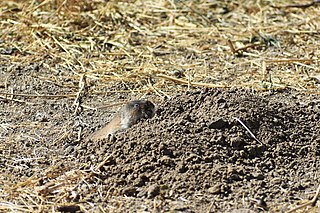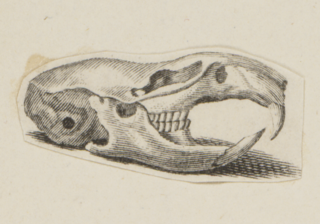
Phodopus, a genus of rodents in the hamster subfamily Cricetinae—a division of the larger family Cricetidae—is a lineage of small hamsters native to central Asia that display unusual adaptations to extreme temperatures. They are the only known hamsters that live in groups and, in some cases, rely on significant contributions by males to the raising of offspring. They are nocturnal and active throughout the year; they do not hibernate. Species of Phodopus, together with members of the genera Cricetulus, Allocricetulus and Tscherskia are called dwarf hamsters because of their small size relative to other hamsters.

Cricetulus is a genus of rodent in the family Cricetidae ; it has seven member species that inhabit arid or semi-arid regions in Eurasia.
Cerradomys marinhus, also known as Marinho's rice rat, is a rodent species from South America. It is found in Minas Gerais, Brazil. It was formerly known as Oryzomys marinhus, but was transferred to the new genus Cerradomys in 2006.
The Gobi Altai mountain vole is a species of rodent in the family Cricetidae. It can be found in China, Mongolia, and the Russian Federation.
The large-eared vole is a species of rodent in the family Cricetidae. It is found in Mongolia and the Russian Federation.
The Mongolian silver vole is a species of rodent in the family Cricetidae. It is found only in Mongolia.
The flat-headed vole is a species of rodent in the family Cricetidae. It is found in China, Kazakhstan, Mongolia, and Russian Federation.
The Tuva silver vole is a species of rodent in the family Cricetidae. It is found in Mongolia and Russian Federation.
Beamys is a genus of rodent in the family Nesomyidae. It contains the following species:
The long-tailed dwarf hamster is a species of rodent in the family Cricetidae. It is found in China, Kazakhstan, Mongolia, and Russia.

The grey dwarf hamster, grey hamster or migratory hamster is a species of rodent in the family Cricetidae. Its range extends from Eastern Europe through the Middle East, Russia and Central Asia to Mongolia and western China. The grey dwarf hamster has grey fur and a head-body length ranging from 85 to 120 mm. The International Union for Conservation of Nature has assessed its conservation status as being of "least concern".

The Zaisan mole vole, or eastern mole vole, is a species of rodent in the family Cricetidae. It is found in central Asia.

The narrow-headed vole is a species of rodent in the family Cricetidae. Ranging over northern and central Asia and also into Alaska, it is the only species in the subgenus Stenocranius.
Maximowicz's vole is a species of rodent in the family Cricetidae. It is found in northeastern China, Mongolia, and eastern Russia.
Clarke's vole is a species of rodent in the family Cricetidae. It is found only in China.

The Mongolian five-toed jerboa or Siberian jerboa is a species of rodent in the family Dipodidae. It is found in China, Kazakhstan, Mongolia, and Turkmenistan.
Tsolov's mouse-like hamster or Syrian calomyscus is a species of rodent in the family Calomyscidae. It is endemic to Syria.
Kozlov's pygmy jerboa is a species of rodent in the family Dipodidae. It is found in northwestern China and southern and eastern Mongolia. Its natural habitat is temperate desert.
Forrest's mountain vole is a species of rodent in the family Cricetidae found within China in northwest Yunnan. The initial study by Hinton in 1923 identified it as morphologically close to the Chinese scrub vole but with a larger body size and longer and darker pelage.
The quaestor hocicudo is a species of rodent in the family Cricetidae. It is found in southeastern Brazil and northeastern Argentina, where it lives in forest and moist and dry scrub.






